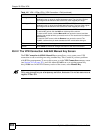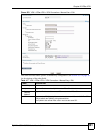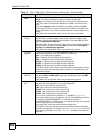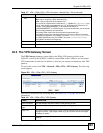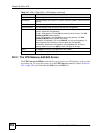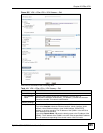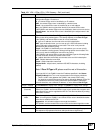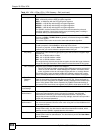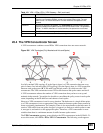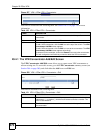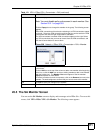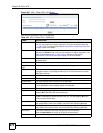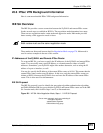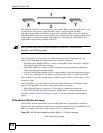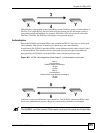
Chapter 20 IPSec VPN
ZyWALL USG 100/200 Series User’s Guide
368
Encryption Select which key size and encryption algorithm to use in the IKE SA. Choices are:
DES - a 56-bit key with the DES encryption algorithm
3DES - a 168-bit key with the DES encryption algorithm
AES128 - a 128-bit key with the AES encryption algorithm
AES192 - a 192-bit key with the AES encryption algorithm
AES256 - a 256-bit key with the AES encryption algorithm
The ZyWALL and the remote IPSec router must use the same key size and
encryption algorithm. Longer keys require more processing power, resulting in
increased latency and decreased throughput.
Authentication Select which hash algorithm to use to authenticate packet data in the IPSec SA.
Choices are SHA1 and MD5. SHA1 is generally considered stronger than MD5,
but it is also slower.
The remote IPSec router must use the same authentication algorithm.
Add icon This column contains icons to add and remove proposals.
To add a proposal, click the Add icon at the top of the column.
To remove a proposal, click the Remove icon next to the proposal. The ZyWALL
confirms that you want to delete the proposal before doing so.
Key Group Select which Diffie-Hellman key group (DHx) you want to use for encryption keys.
Choices are:
DH1 - use a 768-bit random number
DH2 - use a 1024-bit random number
DH5 - use a 1536-bit random number
The longer the key, the more secure the encryption, but also the longer it takes to
encrypt and decrypt information. Both routers must use the same DH key group.
NAT Traversal Select this if any of these conditions are satisfied.
• This IKE SA might be used to negotiate IPSec SA that use active protocol AH.
• There are one or more NAT routers between the ZyWALL and remote IPSec
router, and these routers do not support IPSec pass-thru or a similar feature.
The remote IPSec router must also enable NAT traversal, and the NAT routers
have to forward packets with UDP port 500 and UDP 4500 headers unchanged.
Dead Peer
Detection
(DPD)
Select this check box if you want the ZyWALL to make sure the remote IPSec
router is there before it transmits data through the IKE SA. If there has been no
traffic for at least 15 seconds, the ZyWALL sends a message to the remote IPSec
server. If the remote IPSec server responds, the ZyWALL transmits the data. If
the remote IPSec server does not respond, the ZyWALL shuts down the IKE SA.
More Settings/
Less Settings
Click this button to show or hide the Extended Authentication fields.
Extended
Authentication
When multiple IPSec routers use the same VPN tunnel to connect to a single
VPN tunnel (telecommuters sharing a tunnel for example), use extended
authentication to enforce a user name and password check. This way even
though they all know the VPN tunnel’s security settings, each still has to provide a
unique user name and password.
Enable Extended
Authentication
Select this if one of the routers (the ZyWALL or the remote IPSec router) verifies a
user name and password from the other router using the local user database and/
or an external server.
Server Mode Select this if the ZyWALL authenticates the user name and password from the
remote IPSec router. You also have to select the authentication method, which
specifies how the ZyWALL authenticates this information.
Client Mode Select this radio button if the ZyWALL provides a username and password to the
remote IPSec router for authentication. You also have to provide the User Name
and the Password.
Table 119 VPN > IPSec VPN > VPN Gateway > Edit (continued)
LABEL DESCRIPTION



